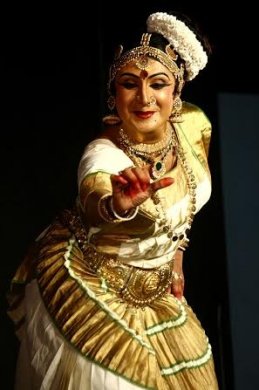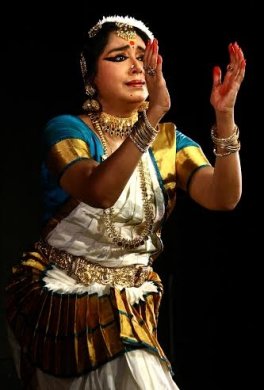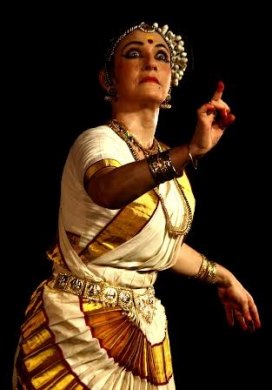
|   |

|   |
Mohini Nrityati - Padma Jayaraj e-mail: padmajayaraj@gmail.com Photos courtesy Manoj Pinarayi January 10, 2016 Mohini Nrityati is an ongoing program for the 6th consecutive year conducted by Kerala Sangeet Nataka Akademi. The aim is to promote and propagate the native classical dance of Kerala which is not as widely known as Bharatanatyam or Kuchipudi. After an eclipse during the colonial times, Kerala Kalamandalam founded by the poet Vallathol tried to rejuvenate it. Mohiniattam reached its present status thanks to the efforts of Kalamandalam and its products. It is still on its emergent course. And the Akademi as the patron of arts has taken it as its bounden duty to assist the artistes in their pursuit of excellence. Thrissur, the cultural capital of Kerala, witnessed the concluding session of a month long program held in ten states of India, in the last three days of December 2015. Krishna Kumar from Irinjalakuda began his performance with pushpanjali, followed by Ananda Ganapathy composed by Kshemavati, a byword in Mohiniattam, the guru of the artiste. It was followed by varnam that showcased nrita and nritya in a composition by late Satyabhama who headed the department in Kalamandalam. The theme was of the lovelorn, a Swati Kriti that epitomizes the nuances of Mohiniattam.  Krishna Kumar From the compositions of the stalwarts, Krishna Kumar showcased his own work in Hindi, evidently to reach his audience in the subcontinent. In raag Yamunakalyani, the dancer portrayed the dreamscape of a dancer who wonders about the statue of a Krishna-Gopika. The sense of wonder moves on to the portrayal of love, fed by music and dance, which ends in sarana manthram, the characteristic Hindu philosophical thought. He concluded the performance with a Tulasidas bhajan that invokes the resplendent Lord Rama for liberation. Mohiniattam is quintessentially a lasya dance, female in its ethos. Krishna Kumar, a male dancer in enchanting make-up and body movement gave an ace performance, the strong point of his art.  Gopika Varma Gopika Varma’s Dasyam Academy of Dance in Chennai came into existence with a vision to promote Mohiniattam. The varnam that Gopika performed showcased the noble theme of dasyam. A string of stories from the purana in which Krishna chose to serve his devotees formed the subtext of the theme. The popular legends Vilwamangalam swamiyar and the old Kurooramma came alive in her classic abhinaya and the inimitable Krishna overwhelmed the spectators. Humans limited by their sense of perceptions fail to capture the vision that their souls long for. Love is the motive force that suffuses dasya in its nobler aspect. It is Radha’s love that made Krishna carry her on his shoulders in spite of her attempt to tease him. The piece where Krishna and Rukmini play dice presents the mystique of dasyam. The music has the ethnic flavor of Kerala’s folk dance that adds to the charm of the gamble. In the finale the gambling game plunges into a whirlpool of love that carries their bet beyond victory and loss. The interpretation of Mahabali myth seemed farfetched, guilt-ridden and artificial. But Madurashtakam, the last and the best, amply compensated by evoking empathy. Yasoda, the mother of Krishna, goes with other Gopikas to have a glimpse of Krishna, the King of Mathura, who is passing by. They wait for the royal procession. Krishna emerges from the memories of Yasoda: the boy Krishna who played pranks, how she saw the reality in his baby mouth, his astonishing dance on the hood of Kaliya and how he left without bidding an adieu. Yasoda recalls the news that came to her: the killing of Kamsa, the meeting with the Pandavas and his mission that evolved from it, the divine messenger of peace, the charioteer of Arjuna, deliverance of Bhagavad Geeta, the milestones in Krishna’s life journey. By then she feels the presence of Krishna close by but fails to recognize him. Who is this, the king? Surely not the child she brought up. With a crushing sense of unease she accepts her loss and settles down to cherishing memories of his idyllic childhood, a mother’s paradise. The artist introduced the story as her own. When the dance ended, each mother felt it was her story. The dance recital resonated with the untold angst of a human situation - a mother’s dasya. The lyrics are composed by Narayana Kutty and music by Madhusoodanan, known figures in Kerala. The live orchestra gave a harmonious backdrop in raag Sahana and adi talam for a gracious Mohiniattam dance recital.  Brigitte Chataignier
The concluding day witnessed a tribute paid by a foreigner to Kerala’s own dance form. Brigitte Chataignier, who studied Mohiniattam from Kalamandalam is a cultural ambassador and a patron of Mohiniattam in Europe. Padma Jayaraj is a freelance writer on the arts. She is a regular contributor to www.narthaki.com. |